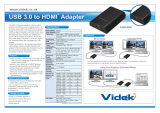
4 Support and troubleshooting
Solving common problems
Minor issues can generally be resolved by using one or more of the following strategies:
●
Unplug (wait for the computer to re-enumerate) and re-plug the HP UHD USB Graphics Adapter, change
the display mode icon in the desktop tray, or change the display mode via Windows Screen Resolution.
●
Upgrade to the latest graphics drivers for your primary graphics card.
●
Upgrade to the latest HP UHD USB Graphics Adapter software.
●
If necessary, boot into Safe Mode and use Windows Backup and Restore Center to recover.
The following table lists possible problems, the possible cause of each problem, and the recommended
solutions.
Problem Possible Cause Solution
The screen of the add-on monitor is
blank.
The add-on monitor takes time
before showing video or is in the
Sleep or Hibernate state.
If the monitor power LED is green or white, wait a
moment. Make sure the computer is not in the Sleep or
Hibernate state. If the monitor is still blank, unplug the
USB cable from the computer and then plug it back in,
making sure the video signal cable between the
computer and adapter is securely connected.
The add-on monitor is not
connected properly.
If the monitor power LED is red, unplug the USB cable
from the computer and then plug it back into the
computer.
The add-on monitor is flickering. The monitor refresh rate is too
low.
In mirror mode, increase the refresh rate of the
primary monitor. This in turn increases the refresh rate
of the add-on monitor.
In extend mode, increase the refresh rate of the add-
on monitor.
The DisplayLink device connected to a
USB 3.0 port on a computer with
Windows 7 shows issues that are not
present when connected to a USB 2.0
port.
USB 3.0 Host controllers on
computers are relatively new,
and the drivers may not be up to
date.
Make sure your USB 3.0 host controller drivers are up
to date. For links to the latest host controller drivers,
see
http://support.displaylink.com/knowledgebase/
articles/544213.
When playing an MPEG file using
Windows Media Player on the extended
monitor, the display becomes abnormal
when switching it to full screen mode.
Windows XP SP2 is not installed. If your system is Windows XP SP1, upgrade it to SP2 to
solve this problem.
When playing a movie in full-screen
mode, the motion is not smooth.
The resolution is set too high or
the monitor is not in the correct
mode or other applications are
using too much of the
computer's resources.
Try the following tips to improve the smoothness of
the movie playback:
●
Reduce the resolution of the display to 640 x 480
or 800 x 600.
●
Use the adapter in extend mode.
●
Terminate any other CPU-intensive applications
running on the computer.
14 Chapter 4 Support and troubleshooting





















